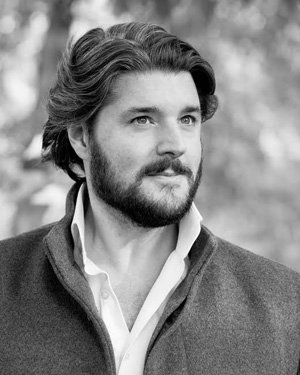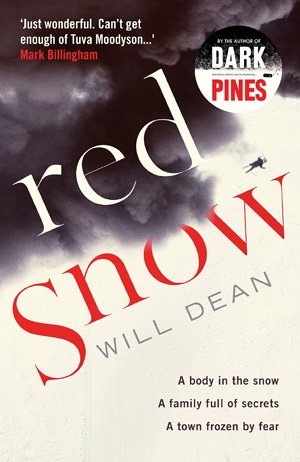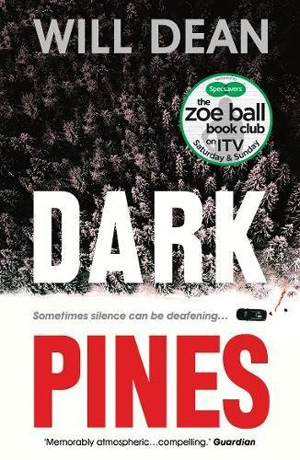
Originally from the East Midlands in the UK, Will Dean now lives in a wooden house he built in the middle of a Swedish forest. He uses the authenticity of this setting to write crime fiction novels that seem as true to the Nordic noir tradition as those of Henning Mankell and Åsa Larsson. Will’s first novel, Dark Pines, was a huge hit and his second, Red Snow, is about to come out. It continues the story of the deaf reporter Tuva Moodyson, who has a knack for solving mysteries alongside writing for the local paper in a small Swedish town. We had to know more…
First of all, can you tell us about your background and how you became a crime author?
I was a weird, socially-awkward kid who took comfort from stories and nature. I still do. I studied law at the London School of Economics, then did a lot of varied jobs. I worked as a labourer on a building site, a waiter, and I sold discount haircut coupons on the streets of London for over a year. Eventually I started designing and managing electronic trading systems. After 8 years of that I moved to a tiny clearing at the centre of a huge Swedish elk forest and built a wooden house.
What do you think crime fiction lovers are going to love about Red Snow?
With Red Snow, readers will experience small-town Sweden in the depths of winter. I hope they’ll enjoy meeting the reclusive, secretive Grimberg family, and trying to work out the identity of the Ferryman killer. This story is packed full of tension, superstition, twists, eccentric characters, and snow!
Tuva Moodyson is back. Tell us about how you developed this character, and who she is. Had you always intended her to be a series character?
Tuva came to me almost fully-formed. Writing Dark Pines, I visualised a huge overgrown pine forest in my mind’s eye. I zoomed in and saw a rough gravel track snaking through the trees. I zoomed in some more and saw a pick-up truck driving. I looked through the window and saw a young woman with hearing aids. I didn’t set out to create a series. I just started writing from Tuva’s point-of-view, and within a few chapters I knew this was different to anything I’d worked on before. Tuva’s voice came through very naturally. I got lucky, I think. She’s extremely fun to write.

Who are some of the other characters we’ll meet in Red Snow and what are they going to get up to?
Red Snow revolves around Grimberg liquorice, the gothic factory that dominates Gavrik town. The three Grimberg women are reclusive and complex. Cici is in her 80s. Fierce and extremely superstitious – she operates from the factory attics. Anna-Britta runs the company. She’s stoic and guarded and still coming to terms with the multiple accidents and tragedies that have afflicted the family in recent years. And then there’s Karin, a young art student obsessed with a mysterious cabinet in the factory’s Grand Room – the dark contents of which were collected by her ancestors. In addition to the Grimbergs and their staff, you’ll find recurring characters from Dark Pines: the wood-carving sisters, David Holmqvist the ghostwriter, Viggo the taxi driver, as well as the staff at the Gavrik Posten – Lena, Nils, and Lars. And, of course, there’s Tuva’s best friend, Tammy.
What were the main challenges for you writing a woman lead character, and how did you overcome them?
I try to be as empathetic as possible. When I’m writing Tuva I think like her for the four weeks it takes me to write a first draft. That month is an immersive, exhausting, buzzy time. I pretty much stay inside her head until I type ‘The End’. I’ve been with my wife for over 20 years and that helps me to understand a woman of Tuva’s age. Many of the most impressive people in my life – my wife, mother, grandmothers, late great-grandmothers, sister, friends – are women. My wife is also my first reader so if I were to write something that jarred she wouldn’t hold back with her criticism!
She’s also hearing-impaired. How did you gain an understanding of this form of disability and how is it reflected in Dark Pines and Red Snow? What were some of the important things you wanted to portray?
I did a huge amount of research into deafness, being hard of hearing, and deaf culture. I watched lots of deaf YouTubers, read deaf bloggers, and followed deaf people on social media. I wanted to learn about their experience in their own words. That learning is an ongoing process. I still research before each new Tuva book, and I strive to understand Tuva’s deafness better. I’m lucky to have a brilliant deaf friend, DG, who accuracy reads each novel before it’s published. Her feedback is invaluable. I’ll never be completely authentic in this respect, but I want to be as accurate and faithful as possible. I want to do Tuva justice.
You’re living in rural northern Sweden. What are the good and bad things of being based there and writing about it? Is it as weird and spooky as it seems?
I love living in the Swedish forest! It’s a wild, magical place. Rich flora and fauna, and intoxicating folklore. But I do miss takeaways. The first full year was quite difficult to adjust. We have no shops or restaurants or cinemas or bookshops close by. Every time I leave the woods the first 15 minutes of driving is off-road so winters can be tough, but fun. We live semi off-grid. We take water from our own well, we process our sewage, we use logs I chop for heating and cooking. It can be a spooky place. Moose trample through the garden. The nights are very, very dark. And sometimes the forest can be eerily noisy, especially in mating season. In autumn, when the elk hunt begins, the sound of high calibre gunfire booms through the pines. I feel very much at home here. The slow pace of life, the simplicity, the distance from the commercial world. I like the way my son doesn’t see or hear cars. He can climb trees and rocks and wander off (within reason) and I don’t need to worry. And the seasons are spectacular. They are distinct. Observations I make here – as an outsider, as someone still very much in awe of the landscape – make their way into Tuva Moodyson novels.

There was a real atmosphere of decay in Dark Pines. Those wet bogs full of sludgy plant matter, parasites attacking at every opportunity, and sometimes rotting flesh. What aspects of the climate and terrain do you draw on in Red Snow?
Yes! In fact Dark Pines was originally called Sweet Rot. There is a real feel of decomposition here in autumn. Lots of organic matter rotting away. Old leaves and pine needles and wood left to nature. The mushrooms are stunning. But all that stops in winter. Red Snow is more about the extreme silence and whiteness. The intrinsic danger all around us. If you leave your house to walk your dog in the woods and it’s -25°C and you trip and break your ankle you could die out in the wilderness. At those temperatures shock and hyperthermia are a real risk. And the forest is so uniform it’s easy to get lost in the endless snow-covered pines trees. The sense of menace is real. In fact, just today, on my way back into the forest, I helped a driver get her car out of a frozen ditch. Red Snow is set in February, the coldest month. It can be an incredibly beautiful time. Sparkling hoare frost and clear skies. But you need to be equipped for a power outage or a slide on black ice. You need to be prepared.
You’re a British writer but your writing seems to fit well into the Nordic tradition in crime fiction. What are your crime writing influences and where do you see your work fitting into the scheme of things?
My writing influences are mainly Anglo-American. I’m a huge fan of Muriel Spark, Patricia Highsmith, Sarah Waters, Cormac McCarthy, Stephen King, Yaa Gyasi, Gillian Flynn, Val McDermid, Shirley Jackson, Ian Rankin, Michel Faber. Stephen King writes about small-town Maine – moose, pine forests, working-class characters – and his stories really resonate with me. I love the atmospheric writing of Gillian Flynn and Jane Harper: stories rooted in a specific time and place. My favourite Scandinavian writers are Peter Høeg and Åsa Larsson. Weather and landscape play a large role in their stories.
Has your book been translated into Swedish and what has the local reception been like?
Not yet! Watch this space.
What’s next for you, and for Tuva?
I’ve just finished Snake River (Tuva 3). And now I have the seed of an idea for Tuva 4. I relish the four weeks each year I get to spend in the forest, being in a kind of trance, writing a new first draft. It’s the other 11 months of rewriting that are tough.
Red Snow comes out on 10 January. Read our review of Dark Pines here.











